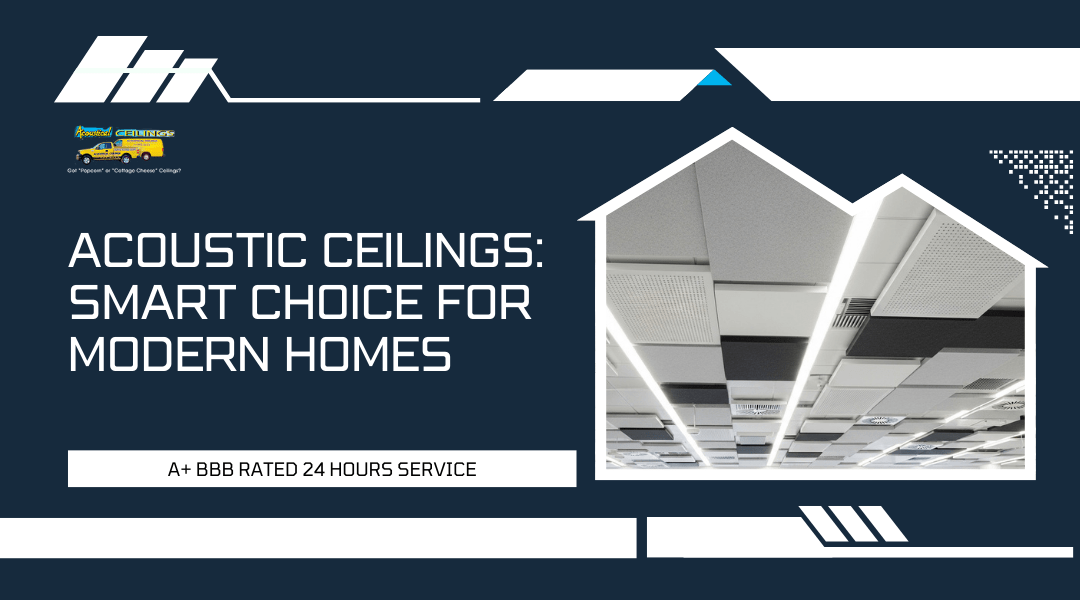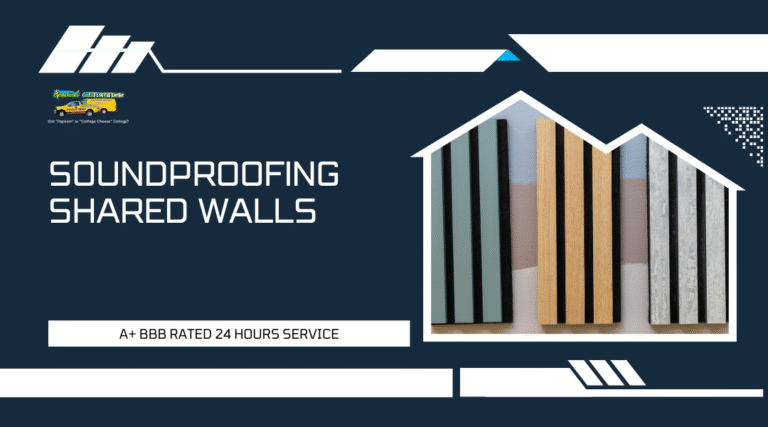Acoustic ceilings offer more than just a clean, finished look for your home. They improve sound control, enhance comfort, and create a polished interior that feels both modern and functional. By choosing acoustic ceilings, you gain better noise reduction, improved energy efficiency, and a versatile design option that fits seamlessly into your space.
You may be considering ways to update your ceilings for both style and practicality. Acoustic ceilings give you flexibility with textures, patterns, and finishes while also addressing common issues like poor acoustics, outdated popcorn ceilings, or inefficient insulation. This combination of function and design makes them a practical upgrade for nearly any home.
At Acoustical Ceilings in Rancho Cucamonga, you can count on expertise built from decades of drywall and ceiling solutions. Whether you want to improve privacy between rooms, lower energy costs, or boost property value, acoustic ceilings provide a smart, lasting investment that balances performance with visual appeal.
Improved Sound Control And Privacy
Acoustic ceilings help you manage unwanted noise, improve room-to-room privacy, and create spaces that feel more comfortable for daily living. By focusing on acoustic performance, you can reduce distractions and make your home better suited for both relaxation and entertainment.
Reducing Noise Between Rooms
When sound easily travels through walls and ceilings, it can disrupt concentration and comfort. Acoustic ceilings add an extra layer of sound absorption that weakens airborne noise like voices, music, or televisions. This makes shared walls and busy areas less intrusive.
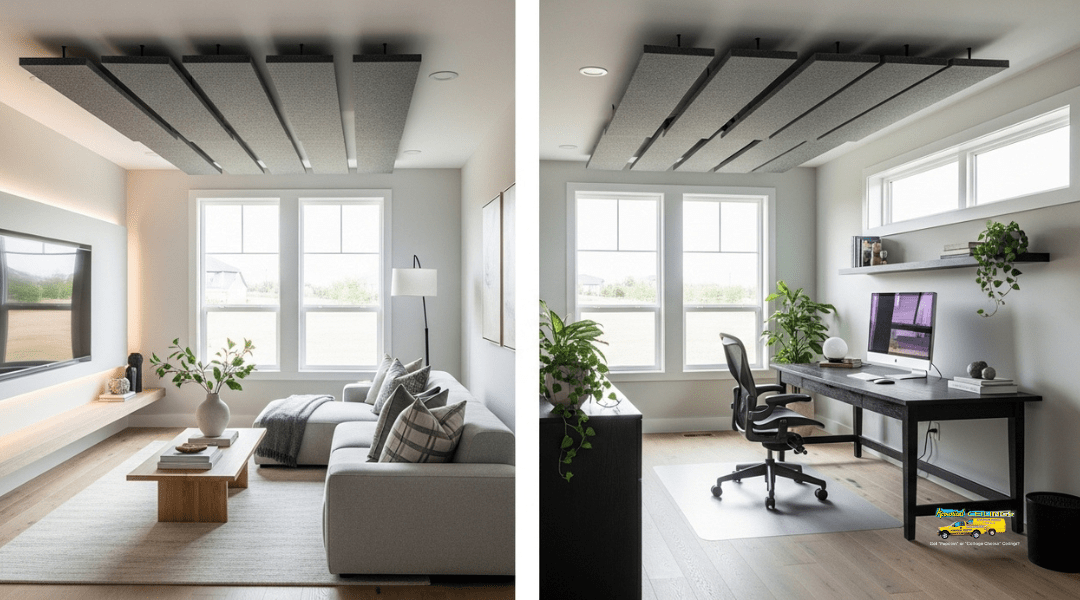
In multi-room homes, especially with open layouts, this control becomes more noticeable. You can hold a conversation in one room without worrying about disturbing someone working or resting in another.
Key benefits include:
- Lower sound transfer between bedrooms and living areas
- Improved privacy for home offices or study spaces
- More consistent noise levels throughout the house
By reducing noise bleed, you gain a quieter and more functional environment.
Creating Quieter Living Spaces
A living room or family area often serves multiple purposes, from socializing to relaxation. Hard surfaces like drywall, tile, and wood tend to reflect noise, which can make these areas feel louder than they should. Acoustic ceilings absorb sound waves and reduce the echo effect.
This absorption improves clarity when talking with others and lowers the overall volume in the room. Even small changes in acoustic performance can make daily activities more comfortable.
You also avoid the fatigue caused by constant background noise. Whether you are reading, working, or simply resting, a quieter space helps you focus and unwind more effectively.
Enhancing Home Theater And Entertainment Areas
Entertainment rooms benefit the most from controlled sound. Acoustic ceilings help keep audio contained within the room, so you can enjoy movies or music without disturbing the rest of the home. This is especially useful in homes where bedrooms are close to media spaces.
By reducing sound reflections, these ceilings also improve the listening experience. Dialogue becomes clearer, and background noise does not overpower the main audio.
For homeowners who enjoy surround sound systems, acoustic performance ensures that effects are crisp and balanced. This creates a more immersive environment while still maintaining privacy for others in the household.
Aesthetic Versatility And Design Appeal
Acoustic ceilings give you flexibility in both function and style. They allow you to improve sound control while also shaping the visual character of a room with clean lines, varied textures, and practical concealment solutions.
Styles And Textures That Complement Any Interior
You can select from smooth, patterned, or textured acoustic panels to match the look of your space. A flat, uniform finish works well in modern interiors, while subtle textures add depth to more traditional rooms.
Many ceiling tiles come in neutral tones like white, beige, or gray, which blend easily with walls and flooring. If you prefer contrast, you can choose darker tones or wood-look finishes to create a more defined ceiling plane.
For homeowners who want variety, manufacturers offer panels with geometric shapes, perforated surfaces, or even metallic finishes. These options let you coordinate the ceiling with lighting fixtures, trim, or furniture.
By choosing the right style, you can make the ceiling either stand out as a design feature or fade into the background for a more minimalist effect.
Concealing Imperfections, Wiring, And Ductwork
Acoustic ceilings also serve a practical purpose by covering uneven drywall, minor cracks, or water stains. Instead of investing in costly repairs, you can install ceiling panels that hide these flaws while keeping the surface uniform.
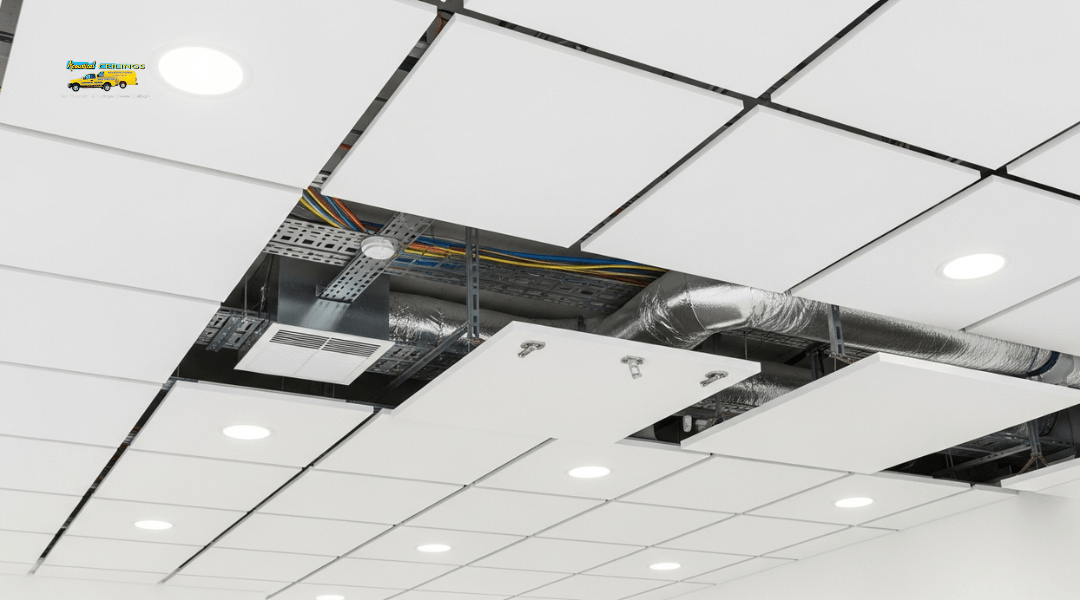
They also help you manage utilities. Electrical wiring, HVAC ductwork, and plumbing lines can be tucked above the panels, keeping them out of sight but still accessible if maintenance is needed.
This concealed space, often called a plenum, provides flexibility for future upgrades. If you decide to add recessed lighting, speakers, or security systems later, you won’t need to open up finished drywall.
The result is a cleaner, more organized ceiling that supports both appearance and functionality without requiring constant upkeep.
Modern Alternatives To Outdated Popcorn Ceilings
If your home still has a popcorn ceiling, replacing it with acoustic panels gives you a modern upgrade. Popcorn finishes often look dated, collect dust, and are difficult to clean. Acoustic ceilings provide a smooth, updated surface that avoids those issues.
You can choose drop-in panels or direct-mount systems, depending on the ceiling height and structure. Both options create a more polished look without the rough texture of sprayed finishes.
Unlike popcorn ceilings, acoustic panels allow for customization in color, shape, and material. This means you can align the ceiling with the rest of your interior design instead of being stuck with a single outdated texture.
By making the switch, you gain a ceiling that feels current, practical, and easier to maintain over time.
Energy Efficiency And Comfort
Acoustic ceilings do more than reduce noise. They also help regulate indoor temperature, cut energy use, and support environmentally responsible building practices.
Insulating Against Heat And Cold
An acoustic ceiling system adds an extra barrier between your living space and the structural ceiling. This barrier traps air pockets that slow down the transfer of heat in summer and retain warmth in winter.
You benefit from more stable indoor temperatures without relying as heavily on heating and cooling systems. This insulation effect becomes especially noticeable in rooms with high ceilings or large open layouts.
By reducing drafts and temperature swings, you create a more consistent level of comfort. This makes your home easier to maintain at the right temperature year-round.
Lowering Energy Bills With Reflective Surfaces
Many acoustic ceiling tiles come with light-reflective finishes. These surfaces bounce both natural and artificial light deeper into a room.
With improved light distribution, you can use fewer fixtures or lower wattage bulbs. This reduces your electricity consumption without sacrificing brightness.
The reflective quality also helps your HVAC system. By reducing heat absorption in summer, ceiling tiles lessen the burden on air conditioning. The combined effect of lower lighting and cooling needs directly contributes to reduced monthly utility bills.
Making Homes More Sustainable With Eco-Friendly Materials
Modern acoustic ceiling panels often use recycled or renewable materials. Common examples include mineral fiber, perlite, and plant-based binders.
By choosing these products, you lower the demand for non-renewable resources and reduce construction waste. Many tiles are also recyclable at the end of their lifespan, which keeps material out of landfills.
Some manufacturers design panels with low volatile organic compound (VOC) emissions. This improves indoor air quality while supporting green building certifications. Using eco-friendly acoustic ceilings allows you to improve comfort and efficiency while aligning your home with sustainable building practices.
Increased Property Value And Market Appeal
Acoustic ceilings can make your home more appealing to buyers by improving both function and appearance. They also contribute to a quieter environment, which many homeowners view as a premium feature, and they provide long-term value through durability and energy efficiency.
Attracting Buyers With Updated Interiors
When buyers walk into a home, they often notice ceilings right away. Outdated or damaged ceilings can make a space feel neglected, while a clean acoustic ceiling creates a finished, modern look.
Acoustic ceilings also hide wiring, ductwork, and imperfections that might otherwise lower a home’s appeal. This gives your interiors a polished appearance without extensive reconstruction.
You can also choose from different tile sizes, textures, and finishes. Options like 2×2 or 2×4 tiles in neutral colors blend with most décor styles, while specialty finishes can highlight design features. By upgrading to acoustic ceilings, you present a home that looks well-maintained and ready to move into, which can increase buyer interest.
Perceived Value Of Quiet, Comfortable Homes
Noise reduction is one of the most noticeable benefits of acoustic ceilings. Buyers often place a high value on homes that feel quiet and private, especially in neighborhoods with busy streets or multi-level living spaces.
Acoustic ceilings absorb sound within a room and reduce noise transfer between floors. For example, a ceiling with a higher NRC (Noise Reduction Coefficient) rating can cut down on echoes, while a strong STC (Sound Transmission Class) rating helps block sound from adjacent spaces.
This added comfort makes daily living more enjoyable. A quieter environment can make bedrooms more restful, living rooms more relaxing, and home offices more productive. Buyers see these qualities as upgrades that set your property apart from others on the market.
Long-Term Return On Investment
Acoustic ceilings not only improve immediate appeal but also support long-term value. They are relatively easy to maintain since individual tiles can be replaced if damaged, saving you from costly repairs.
They also contribute to energy efficiency. Lighter-colored tiles reflect light, which can reduce the need for artificial lighting and help lower utility costs.
Because they improve both function and appearance, acoustic ceilings can justify a higher asking price when you decide to sell. The combination of lower maintenance, better comfort, and improved aesthetics creates a return on investment that extends well beyond the initial installation.
Durability And Low Maintenance Benefits
Acoustic ceilings provide practical advantages that save you time and money over the years. They hold up well under daily use, require minimal upkeep, and can be refreshed or repaired without the hassle of replacing large sections of material.
Resistance To Cracks, Stains, And Water Damage
Unlike traditional drywall, acoustic ceiling panels are less prone to cracking because they are designed to flex slightly with building movement. This flexibility helps reduce visible damage in areas where small shifts or vibrations occur.
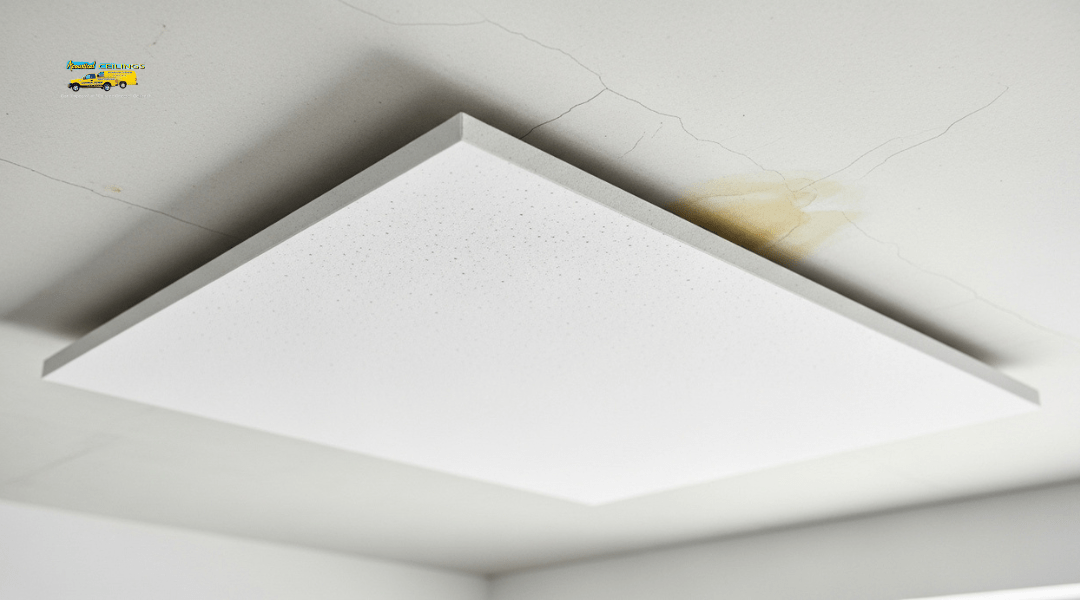
Many panels also include finishes that resist staining from dust, smoke, or minor spills. If discoloration does occur, you can usually clean the surface with a mild detergent rather than repainting.
Moisture resistance is another key feature. Certain acoustic ceiling materials are treated to handle humidity better than drywall, making them suitable for kitchens, bathrooms, or basements where water exposure is more common. Choosing water-resistant panels helps prevent warping and mold growth.
Key benefits:
- Reduced cracking from structural shifts
- Easier cleaning of surface stains
- Better protection in humid environments
Easy Repairs Compared To Traditional Drywall
When drywall is damaged, repairs often involve cutting, patching, sanding, and repainting, which can be time-consuming. Acoustic ceilings simplify this process because you can replace an individual panel without disturbing the rest of the ceiling.
This modular design means you don’t need to redo entire sections if only one part is affected. For example, if a leak stains a tile, you can remove and replace just that tile in minutes.
Repairs are also cleaner. You avoid dust from sanding or paint fumes, making it less disruptive to your living space. This convenience is especially valuable if you want to maintain a finished look without scheduling major work.
Repair process comparison:
| Feature | Acoustic Ceiling | Drywall Ceiling |
|---|---|---|
| Localized replacement | Yes | No |
| Requires repainting | No | Yes |
| Repair time | Minutes | Hours/Days |
Longevity With Proper Care
With routine care, acoustic ceilings can last for decades. Their durability comes from both the materials used and the ease of replacing individual panels when needed. You don’t have to worry about repainting every few years, which extends the lifespan of the installation.
Maintenance usually involves light cleaning with a vacuum or soft cloth to remove dust. Occasional inspection for moisture or damage ensures that any issues are addressed quickly before they spread.
By keeping the panels clean and replacing damaged ones promptly, you maintain both appearance and performance. This long service life makes acoustic ceilings a cost-effective choice compared to ceilings that require frequent refinishing.
Simple care tips:
- Dust panels every few months
- Inspect for leaks or water spots
- Replace damaged tiles immediately
Health And Safety Advantages
Acoustic ceilings can do more than improve sound control in your home. They also contribute to a safer and healthier indoor environment through better air quality, fire resistance, and protection against moisture-related issues.
Improving Indoor Air Quality With Dust Control
Dust and airborne particles often collect on flat, unfinished surfaces. Acoustic ceiling panels are designed with smooth, sealed finishes that make cleaning easier and reduce the buildup of dust. This helps you maintain a cleaner indoor environment with less frequent deep cleaning.
Some panels also use low-VOC (volatile organic compound) materials, which means fewer chemical emissions into the air. This can be especially important if you or your family members have allergies, asthma, or chemical sensitivities.
Regular maintenance is simple. A soft brush or vacuum attachment can remove dust without damaging the surface. By reducing particle accumulation, you improve indoor air quality and create a more comfortable living space.
Fire-Resistant Options For Added Protection
Many acoustic ceiling systems are manufactured with fire-rated materials. These panels are tested to slow the spread of flames, giving you additional time to respond in case of an emergency.
When installed correctly, fire-rated ceilings can help contain a fire to one area of the home. This added layer of protection can reduce property damage and improve safety for occupants.
Fire resistance levels vary by product. You should look for panels that meet ASTM E84 or similar safety standards, which measure flame spread and smoke development. Choosing the right option ensures your ceiling adds both acoustic and protective value.
Mold And Mildew Resistance In Damp Areas
Moisture is a common issue in bathrooms, kitchens, and basements. Standard drywall ceilings can absorb water, leading to mold or mildew growth. Acoustic ceiling panels designed with moisture-resistant cores and treated surfaces help prevent this problem.
These panels resist warping, staining, and microbial growth, which extends their lifespan in humid conditions. By reducing the risk of mold, you also reduce potential health concerns such as respiratory irritation.
For areas with high humidity, you can combine acoustic ceilings with proper ventilation. This dual approach helps maintain both structural integrity and indoor air quality, giving you a safer and more durable ceiling solution.
When To Consider Acoustic Ceilings For Your Home
You may find acoustic ceilings useful when updating older spaces, creating a quieter work environment, or reducing sound transfer between living areas. They balance function and design by improving comfort while also addressing practical noise issues.
Renovations And Modern Upgrades
During a remodel, you often want to improve more than just the look of a room. Acoustic ceilings let you update the style while also addressing sound control, which older ceiling materials usually lack.
They work well in kitchens, living rooms, or basements where noise tends to echo. By absorbing sound, they make conversations clearer and reduce the “hollow” effect common in large or open layouts.
You can also choose from different finishes—smooth, textured, or patterned—so the ceiling matches your design goals. Many options are made from mineral fiber or fiberglass, which are both durable and resistant to moisture.
For homes with recessed lighting or HVAC systems, acoustic ceiling tiles fit easily into suspended grid systems, making them practical for upgrades without major structural changes.
Home Offices And Remote Work Needs
If you work from home, controlling noise becomes a priority. Acoustic ceilings help reduce distractions from household activity, outdoor traffic, or even your own voice echoing in the room.
This is especially useful in spaces where you take video calls or need to focus for long periods. By improving speech clarity, acoustic ceilings make conversations easier to follow without needing to raise your voice.
Unlike wall treatments, ceilings cover a large surface area that directly affects how sound travels. Adding acoustic panels overhead can reduce reverberation and create a more professional environment for remote work.
You also benefit from the insulation properties of some ceiling tiles. They can help regulate room temperature, which may lower energy use when you spend long hours in your office.
Multi-Unit Or Shared Living Spaces
If you live in a duplex, apartment, or multi-level home, sound often travels between floors or through shared walls. Acoustic ceilings reduce this transfer by absorbing and dampening noise before it passes into other units.
This makes them valuable in bedrooms, living rooms, or any area where privacy matters. A properly installed ceiling system can noticeably cut down on footsteps, voices, or TV sounds from nearby spaces.
You can choose fiberglass for lightweight absorption or mineral fiber for stronger sound control. In moisture-prone areas like bathrooms or kitchens, metal ceiling panels may be a better option since they resist mold and mildew.
By addressing noise at the ceiling level, you improve comfort for both you and your neighbors, making shared living more practical and less stressful.

